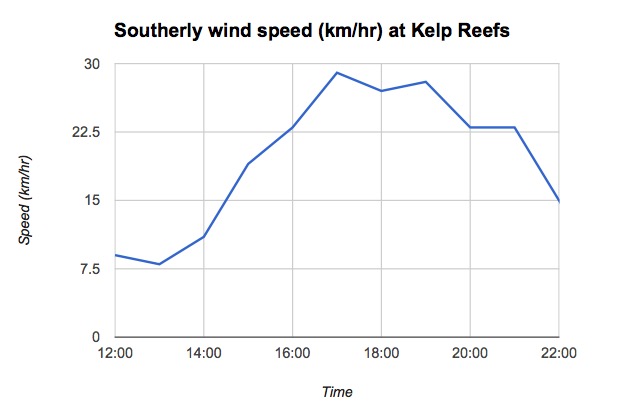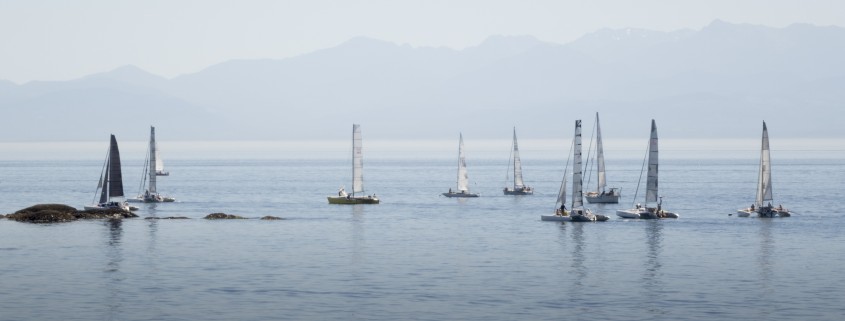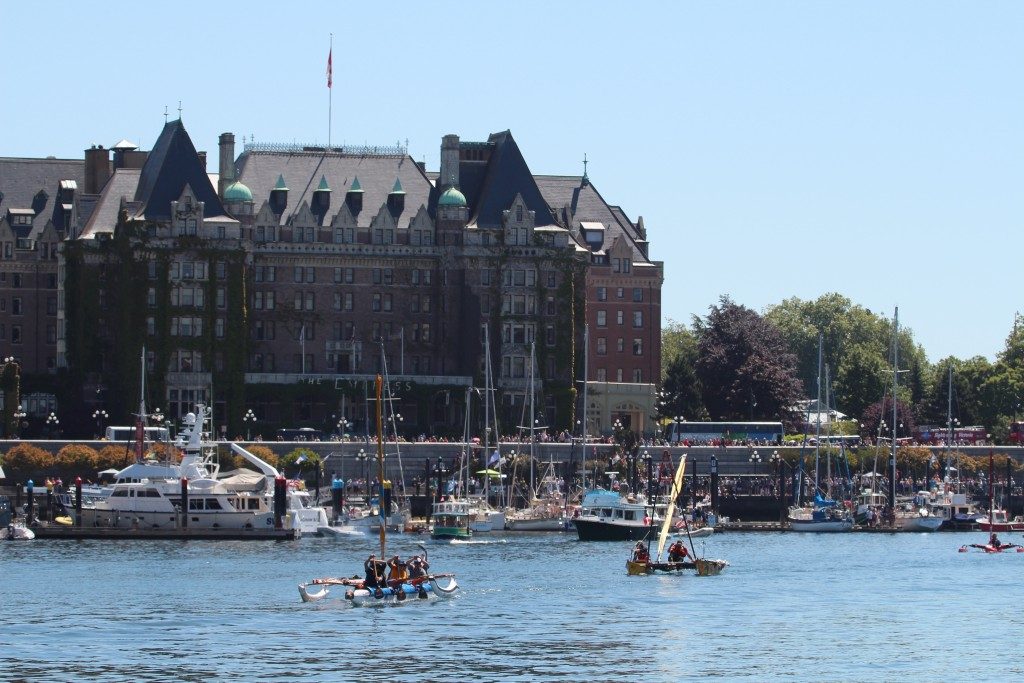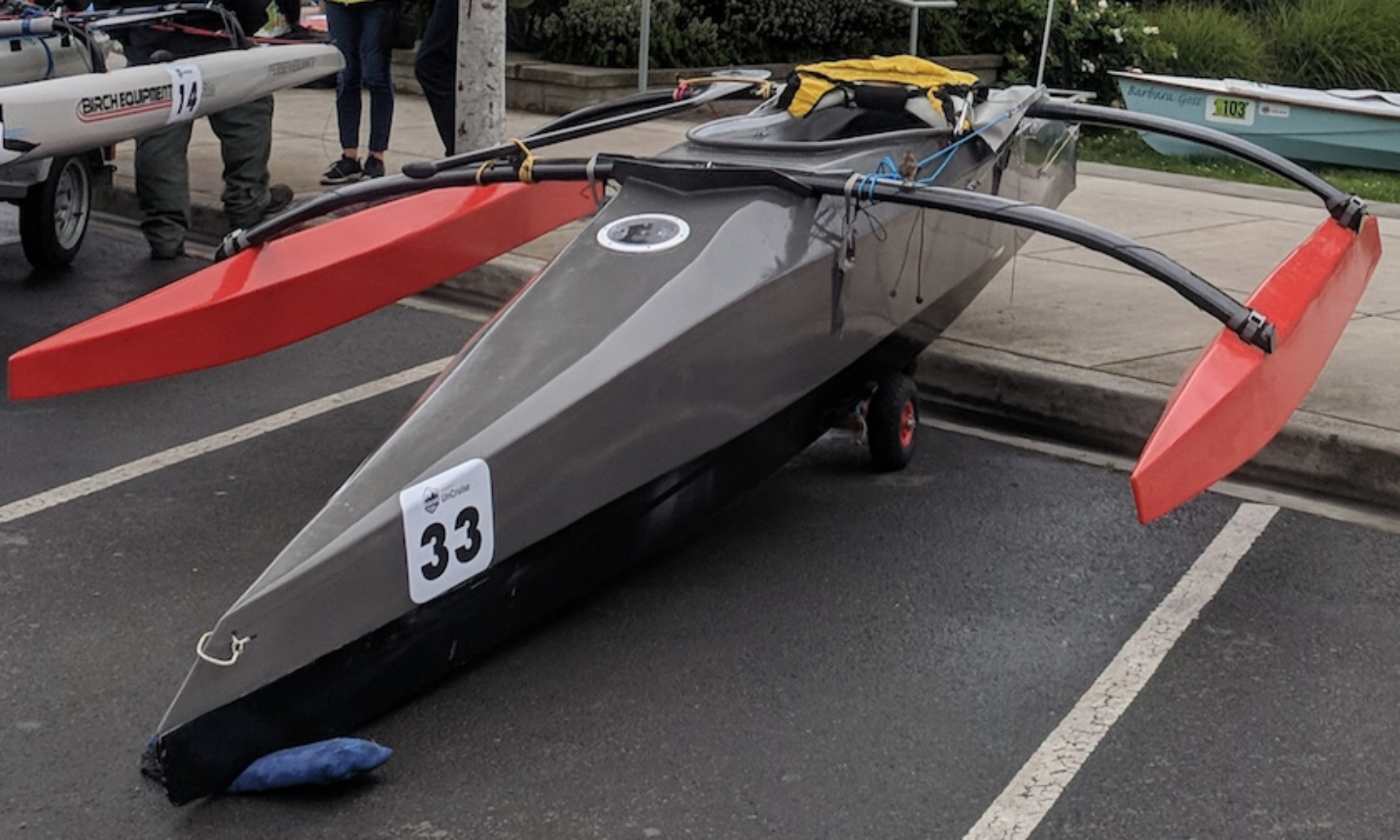While most of the 2015 Race to Alaska (R2AK) was rather breezy, the very beginning of stage 2 (from Victoria to Ketchikan) offers an opportunity to compare the speeds of the diverse boat types in the fleet. Not only is sailing not allowed in the inner harbor of Victoria, but there was virtually no wind during the first couple hours of the Race. As the ebb tide weakened and the bulk of the fleet made the big left turn from the Strait of Juan de Fuca into Haro Strait, a light southerly filled in and the sailboat race began (see plot of wind speed at Kelp Reefs below).

This near-calm period affords an opportunity to compare the speeds of the many different types of human-powered propulsion that were utilized by the 2015 fleet. Boats with a wide range of designs and displacements used oars while others tried 1- or 2-bladed paddles. A hand full of technological innovators used pedal-powered propellers or adaptations of the Hobie Mirage drive.

While a more quantitative assessment is warranted (maybe with GPS Action Replay?), with the excitement of the 2016 upon us, I tried a simpler approach. Assume that everyone started at about the same time (high noon on Sunday June 7, 2015), that the whole fleet cleared Point Gonzales before any meaningful amount of wind set in, and that everyone experienced about the same set from the ebb. Here’s the current situation at Race Rocks for that day:
2015-06-07 Sun 5:14 AM PDT Sunrise 2015-06-07 Sun 5:38 AM PDT 0.6 knots Max Flood 2015-06-07 Sun 6:47 AM PDT -0.0 knots Slack, Ebb Begins 2015-06-07 Sun 11:12 AM PDT -5.3 knots Max Ebb 2015-06-07 Sun 3:05 PM PDT 0.0 knots Slack, Flood Begins 2015-06-07 Sun 6:09 PM PDT 5.3 knots Max Flood 2015-06-07 Sun 9:11 PM PDT Sunset
With those assumptions in place (and with the caveat that any ebb current would reduce the apparent speed of the R2AK boats as measured by their SPOT transceivers), I next measured the point-to-point distance from the Empress marina in the Inner Harbor of Victoria to Point Gonzales (just NE of Trial Islands). It’s ~10.5 km. I then used the R2AK tracker re-play function to estimate the time that each boat passed Point Gonzales. (This is a little tricky due to the 15 minute location interval, but if we assume constant speed during those 15 minutes we can approximate the time at which a boat passed the Point to within a minute or two.)
Here are the results (also available within this Google spreadsheet of Inter-annual R2AK Statistics) —
| Team | Human power (primary) | Victoria – Gonzales Pt. (10.5 km) speed (kts) | Victoria – Gonzales Pt. (10.5 km) speed (kph) |
| Broderna | oars | n/a | n/a |
| Barefoot Wooden Boats | oars | n/a | n/a |
| Soggy Beavers | paddle | 5.00 | 9.26 |
| Hexagram 59 | pedal | 4.00 | 7.41 |
| Sea Runners | pedal | 3.70 | 6.85 |
| Turn Point Design | pedal | 3.66 | 6.77 |
| Discovery | mirage | 3.58 | 6.63 |
| Mike’s Kayak | paddle (2 blade) | 3.40 | 6.30 |
| Pure & Wild | pedal | 3.27 | 6.06 |
| Boatyard Boys | oars | 3.15 | 5.83 |
| Mau | pedal | 3.09 | 5.73 |
| John | paddle (1 blade) | 3.04 | 5.63 |
| Elsie Piddock | oars | 2.93 | 5.43 |
| Puffin | pedal | 2.91 | 5.38 |
| MOB Mentality | oars | 2.88 | 5.34 |
| Kohara | pedal | 2.86 | 5.29 |
| Un-cruise | mirage | 2.79 | 5.16 |
| Blackfish | oars | 2.77 | 5.12 |
| Grin | oars | 2.77 | 5.12 |
| Por Favor | oars | 2.77 | 5.12 |
| Golden Oldies | oars | 2.68 | 4.96 |
| Coastal Express | oars | 2.52 | 4.67 |
| Excellent Adventure | oars | 2.50 | 4.63 |
| Real Thing | pedal | 2.38 | 4.41 |
| Free Burd | oars | 2.36 | 4.38 |
| Y Triamoto | oars | 2.36 | 4.38 |
| Super Friends | oars | 2.36 | 4.38 |
| Seawolf | pedal | 2.00 | 3.71 |
The range of speeds (5.0-2.0 knots, or 9.3-3.7 kph) is not that big — though it feels substantial when you’re getting passed by someone on the course, or trying to catch up to a boat that’s “just ahead!” I certainly recall being appalled at how fast the Soggy Beavers (44′ OC-6, mean speed 5.0 knots) overtook our 17′ catamaran (pedal+paddle power, mean speed 3.7 knots) in the first few minutes of the race (see below)! [There’s no data for 2 boats that had SPOT trackers that weren’t working during the start.]

The fastest boat (Team Soggy Beavers) was a long, narrow, lightly-loaded hull propelled by Canadians using the most tried-and-true technology on the Pacific Northwest coast: the canoe paddle. The next three fastest boats used pedal drives, assisted in some cases by a paddle: Hexagram 59 was relentless in their use of a supplementary SUP paddle (always on the port side!); Sea Runners occasionally took vigorous strokes with a canoe paddle. Turn Point Design had a carbon fiber cat driven by the largest prop among the pedal-powered boats.
One interesting pattern is that the 7 top speeds were obtained with less traditional methods (not rowing). After them, came the three fastest boats that were rowed: the Boatyard Boys (small boat, strong rowers; coincidentally almost matched by Team Mau with an athwartship pedal system), Elsie Piddock (the winners of the windy 2015 R2AK), and MOB Mentality. This pattern hints that there are still speed gains to be made by both rowers and technological innovators. This year Colin Angus and Mathieu Bonnier will bring a LOT of rowing experience to the race.
And Matt Johnson will bring some serious pedal power. His interest in pedal-powered boats is partly fueled by an interest in breaking the World record for 24-hour distance in a human powered boat. This Google spreadsheet of human-powered boat speed records and measurements shows how high the bar has been set over the years — primarily by pedal boats and kayakers. The speeds maintained over 24-hours have been creeping up over the decades. Kayaks have gone from 8.04 kph in 1988 to 10.15 kph in 2013, while pedal-powered boats have increased dramatically from 3.76 kph in 2000 to 10.22 in 2008.
Overall the 2015 R2AK boat speeds over those first 10.5 km bracket the speeds maintained over long distances by rowers and kayakers (3-5 kph; e.g. Colin and Julie rowing across the Atlantic averaged 3.9 kph). But the upper R2AK speeds aren’t far from the World record paces of pedal-boater Greg Kolodziejzyk (10.5 kph) or Bellingham-based kayaker Brandon Nelson (10.22 kph). The top sprinting speeds achieved historically indicate an upper edge of what current technology may soon deliver over a long course like the R2AK (ignoring factors that limit human endurance): 17.6 kph for Gordie Nash in a pedal boat; 20.55 kph (11 knots!) for Olympic kayak men’s K4 sprint.
Who do you think will beat the “Point Gonzales record” (of 5 knots) this year?
For the competition to be “fair” from year to year, the current situation should be about the same. It looks like Jake did a good job of leveling the playing field:
2016-06-26 Sun 5:14 AM PDT Sunrise 2016-06-26 Sun 5:26 AM PDT 0.0 knots Slack, Flood Begins 2016-06-26 Sun 6:47 AM PDT 0.9 knots Max Flood 2016-06-26 Sun 8:24 AM PDT -0.0 knots Slack, Ebb Begins 2016-06-26 Sun 12:18 PM PDT -4.2 knots Max Ebb 2016-06-26 Sun 3:57 PM PDT 0.0 knots Slack, Flood Begins 2016-06-26 Sun 6:55 PM PDT 4.5 knots Max Flood 2016-06-26 Sun 9:19 PM PDT Sunset
The slack will come about an hour later this year, but the max ebb is about a knot less than last year. May the best technology and most powerful racer win!

Great data, Matt! Thanks. One correction: Team Mau’s primary human power mode was an “athwartships” pedal drive.